Hol Dir den wöchentlichen SPARTANAT-Newsletter.
Dein Bonus: das gratis E-Book von SPARTANAT.
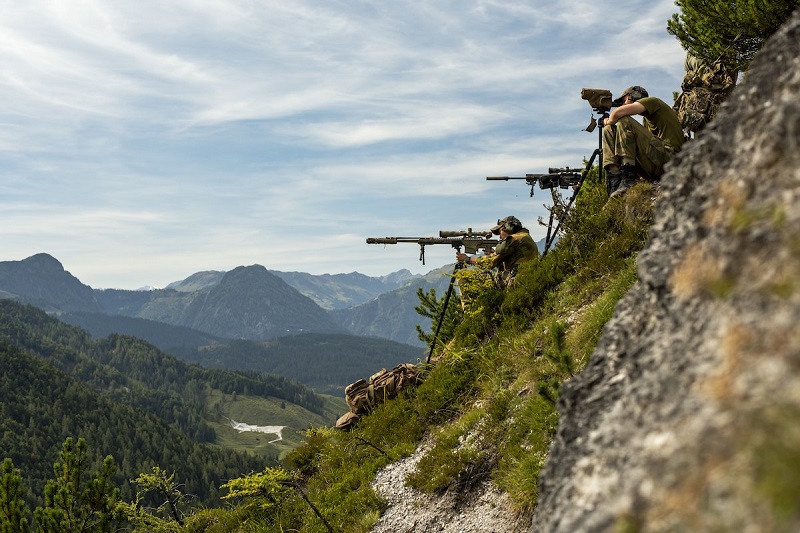
Steile Winkel, hohe Berge: Scharfschützen in den Alpen
Schießen im steilen Winkel – eine schwierige Angelegenheit. Weil das Projektil einen längeren Weg zurücklegen muss, kann die Schwerkraft eine längere Zeit auf das Geschoss wirken. Eine weitere Schwierigkeit ist es, die passende Schussposition zu finden. Genau solche komplexen Schüsse übten NATO-Scharfschützen vom 9. bis zum 14. September am Truppenübungsplatz Hochfilzen, in den österreichischen Alpen. Dabei sind eindrucksvolle Bilder entstanden, die wir euch nicht vorenthalten wollen. Auch der Schuss über Täler hinweg stand am Kursprogramm, oben im Bild norwegische Sniper bei der Arbeit in der alpinen Idylle.
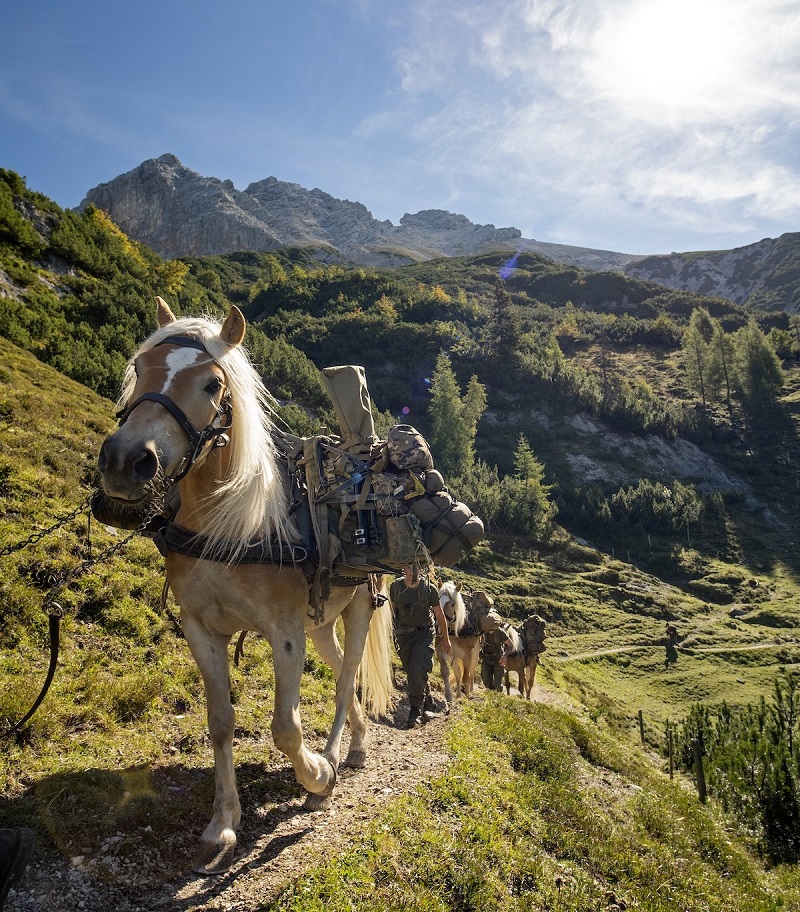 Während des Kurses mussten die NATO-Scharfschützen mehrmals auf bis zu 2.000 Meter hochmarschieren. Tragtiere des Österreichischen Bundesheeres halfen beim Transport der Ausrüstung.
Während des Kurses mussten die NATO-Scharfschützen mehrmals auf bis zu 2.000 Meter hochmarschieren. Tragtiere des Österreichischen Bundesheeres halfen beim Transport der Ausrüstung.
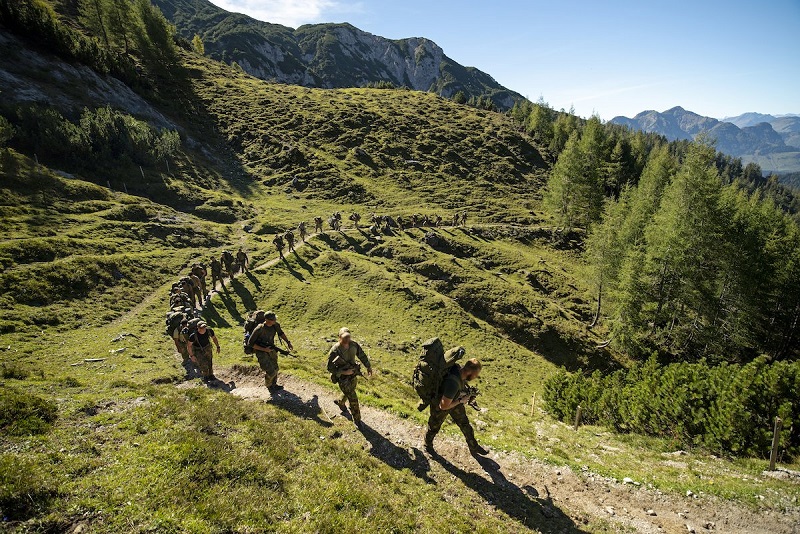 Besonders in alpinem Gelände ist es notwendig, die mitgeführte Ausrüstung möglichst leicht zu halten. In den fünf Kurstagen lernten die Teilnehmer, das Essenzielle vom Überflüssigen zu trennen und so eine angemessene Packordnung herzustellen.
Besonders in alpinem Gelände ist es notwendig, die mitgeführte Ausrüstung möglichst leicht zu halten. In den fünf Kurstagen lernten die Teilnehmer, das Essenzielle vom Überflüssigen zu trennen und so eine angemessene Packordnung herzustellen.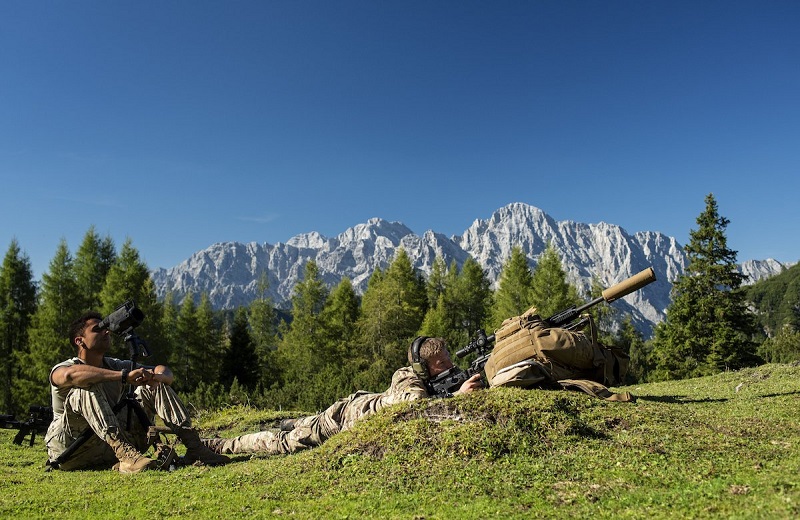 Im Übungsraum angekommen ging es dann auch schon los. Für den Schuss im steilen Winkel müssen besondere mathematische Berechnungen vorgenommen werden, damit das Ziel bekämpft werden kann.
Im Übungsraum angekommen ging es dann auch schon los. Für den Schuss im steilen Winkel müssen besondere mathematische Berechnungen vorgenommen werden, damit das Ziel bekämpft werden kann.
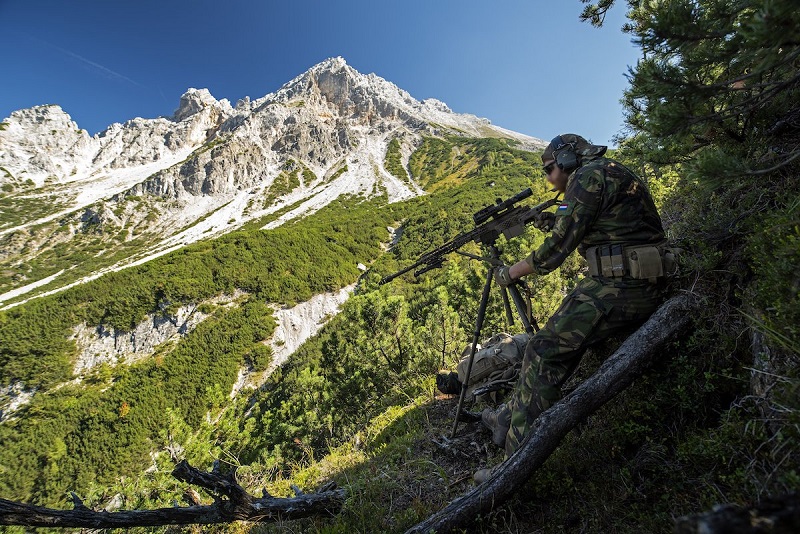 Ein niederländischer Scharfschütze bekämpft ein Ziel im Tal. Ob er sich am Dreibein festhält, weil es es steil ist: wir wissen es nicht.
Ein niederländischer Scharfschütze bekämpft ein Ziel im Tal. Ob er sich am Dreibein festhält, weil es es steil ist: wir wissen es nicht. 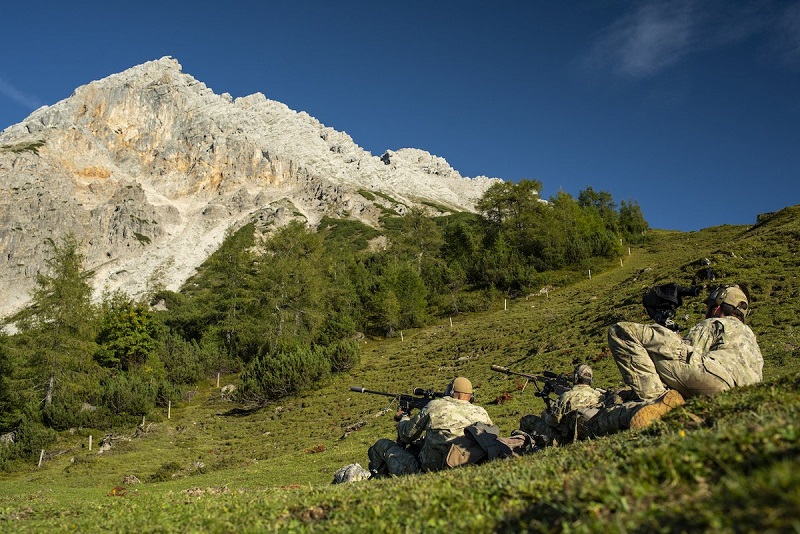 Scharfschützen der italienischen Gebirgsjäger beim Schießen auf höherliegende Ziele.
Scharfschützen der italienischen Gebirgsjäger beim Schießen auf höherliegende Ziele.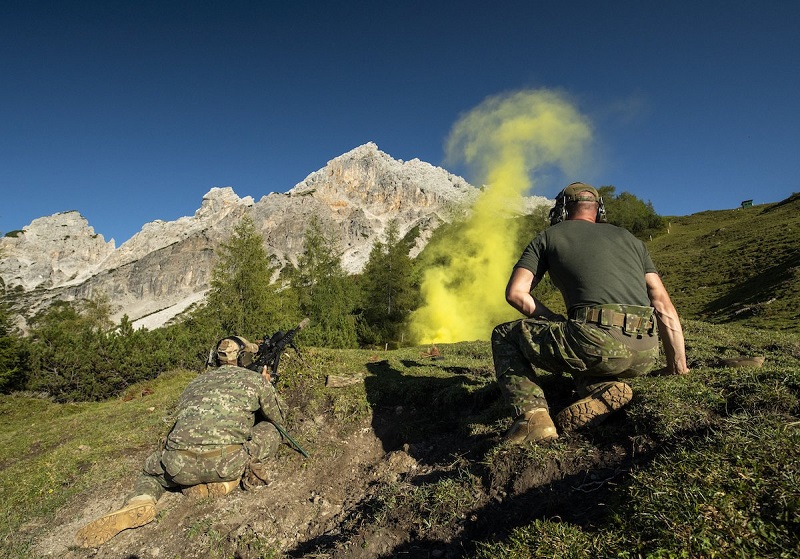 Um Windrichtung und Windstärke zu ermitteln kann auch Rauch eingesetzt werden.
Um Windrichtung und Windstärke zu ermitteln kann auch Rauch eingesetzt werden.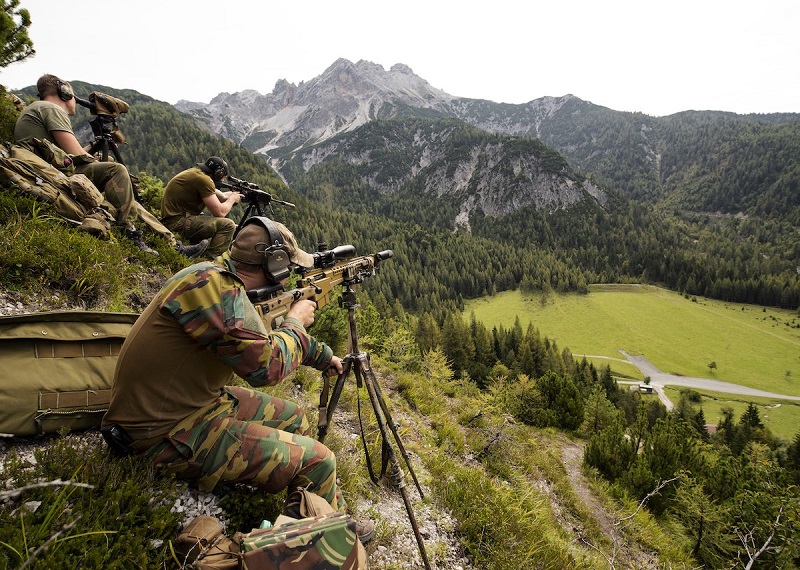 Laut einem Kursteilnehmer liegt die wahre Herausforderung weniger in der besonderen Berechnung der Geschoßbahn – diese sei relativ einfach – sondern im Finden der passenden Position für die Schussabgabe. Bei Schüssen über schwierige Winkel hat es auch der Spotter oft schwer, eine gute Sichtlinie herzustellen.
Laut einem Kursteilnehmer liegt die wahre Herausforderung weniger in der besonderen Berechnung der Geschoßbahn – diese sei relativ einfach – sondern im Finden der passenden Position für die Schussabgabe. Bei Schüssen über schwierige Winkel hat es auch der Spotter oft schwer, eine gute Sichtlinie herzustellen.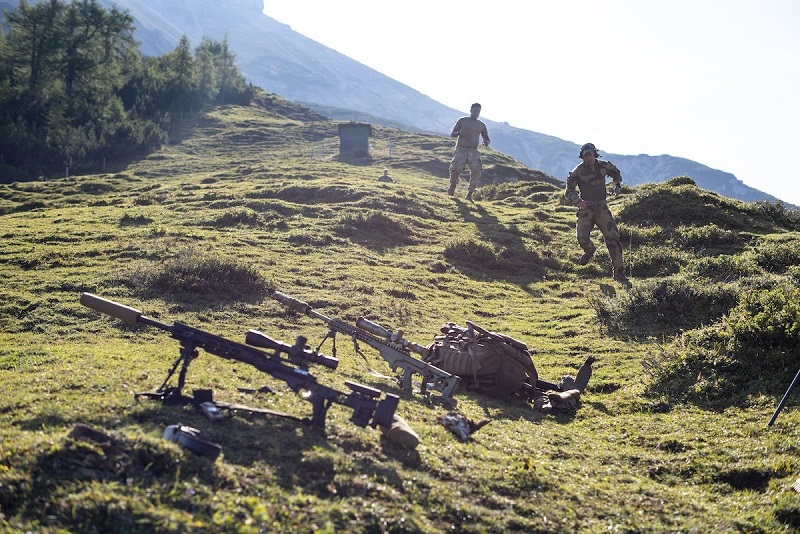 Um Gefechtssituationen zu simulieren, wurde das Schießtraining auch mit sportlichen Übungen verbunden. Bei diesen „Stress-Drills“ werden die Soldaten körperlich belastet und müssen im Anschluss sofort ihr Können an der Waffe beweisen.
Um Gefechtssituationen zu simulieren, wurde das Schießtraining auch mit sportlichen Übungen verbunden. Bei diesen „Stress-Drills“ werden die Soldaten körperlich belastet und müssen im Anschluss sofort ihr Können an der Waffe beweisen.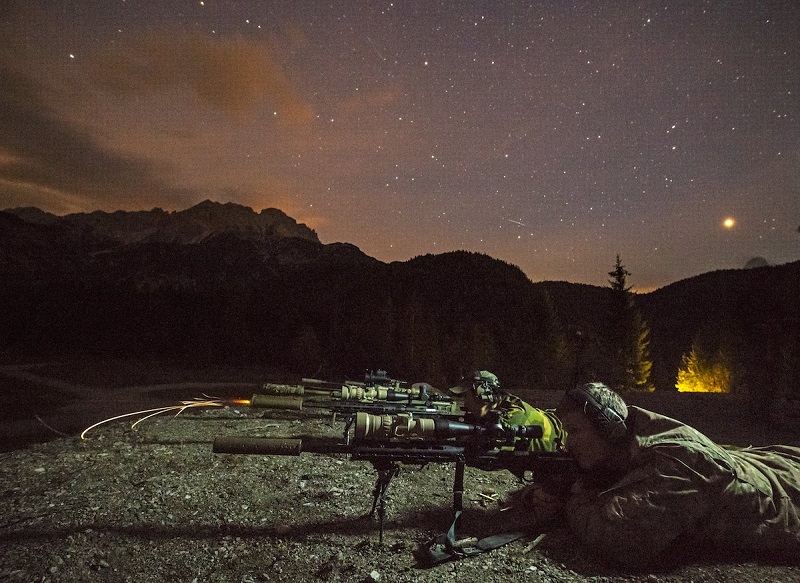 Im Kurs wurde großer Wert auf die internationale Zusammenarbeit gelegt. So wurden auch Sniperteams aus unterschiedlichen Ländern zusammengestellt. Am Bild ist etwa ein norwegischer Scharfschütze zu sehen, der von einem Spotter der US-Army unterstützt wird. Durch die Mischung der Teams und Wettbewerbe zwischen den Ländern wird ermöglicht, voneinander zu lernen. Beachte hier die thermalen Vorsatzgeräte für den Nachtschuss.
Im Kurs wurde großer Wert auf die internationale Zusammenarbeit gelegt. So wurden auch Sniperteams aus unterschiedlichen Ländern zusammengestellt. Am Bild ist etwa ein norwegischer Scharfschütze zu sehen, der von einem Spotter der US-Army unterstützt wird. Durch die Mischung der Teams und Wettbewerbe zwischen den Ländern wird ermöglicht, voneinander zu lernen. Beachte hier die thermalen Vorsatzgeräte für den Nachtschuss.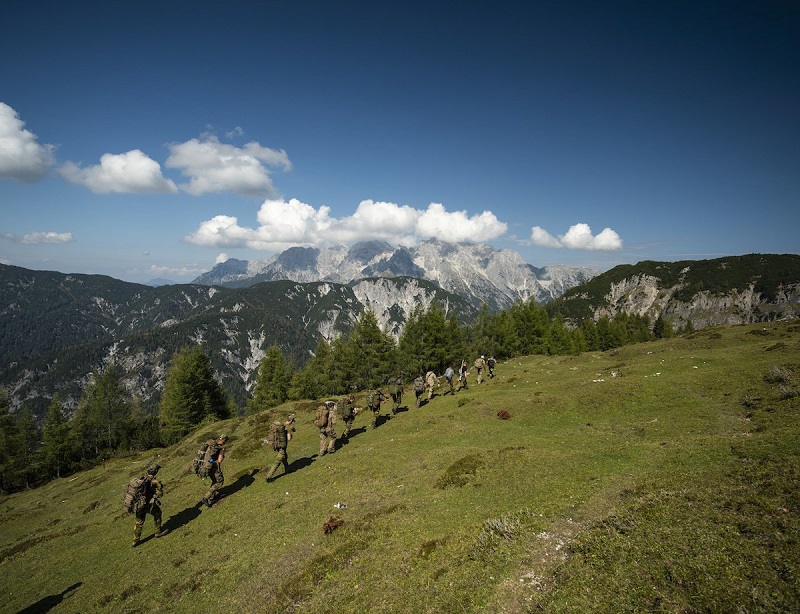 Derartige Einsätze wie sie am Kurs geübt wurden, gehören nicht zum Trainingsalltag der teilnehmenden Soldaten. Das liegt einerseits daran, dass solche Schüsse an sich selten sind und andererseits an fehlenden Übungsmöglichkeiten. Insgesamt waren die Teilnehmer deshalb sehr erfreut, diese spezielle Fähigkeit in Hochfilzen schärfen zu können.
Derartige Einsätze wie sie am Kurs geübt wurden, gehören nicht zum Trainingsalltag der teilnehmenden Soldaten. Das liegt einerseits daran, dass solche Schüsse an sich selten sind und andererseits an fehlenden Übungsmöglichkeiten. Insgesamt waren die Teilnehmer deshalb sehr erfreut, diese spezielle Fähigkeit in Hochfilzen schärfen zu können.
SPARTANAT ist das Online-Magazin für Military News, Tactical Life, Gear & Reviews.
Schickt uns eure News: [email protected]
Werbung
Hol Dir den wöchentlichen SPARTANAT-Newsletter.
Dein Bonus: das gratis E-Book von SPARTANAT.


